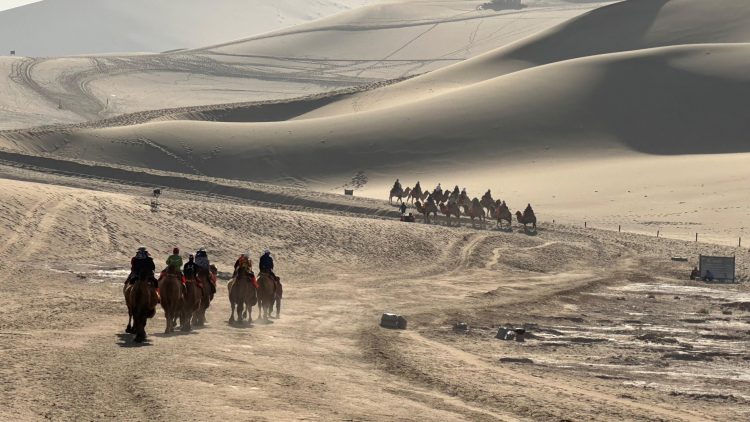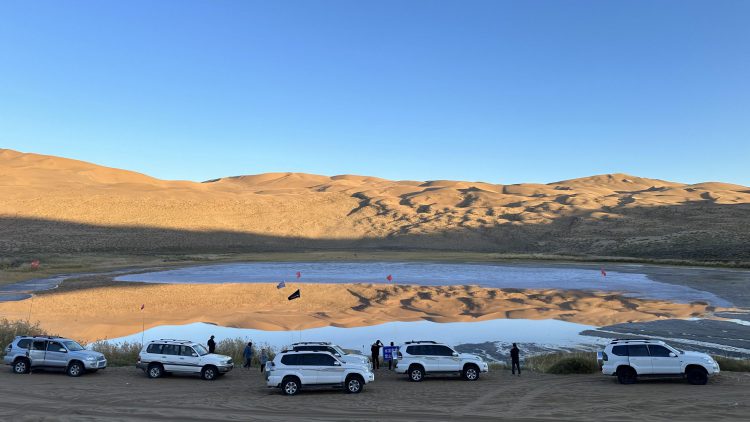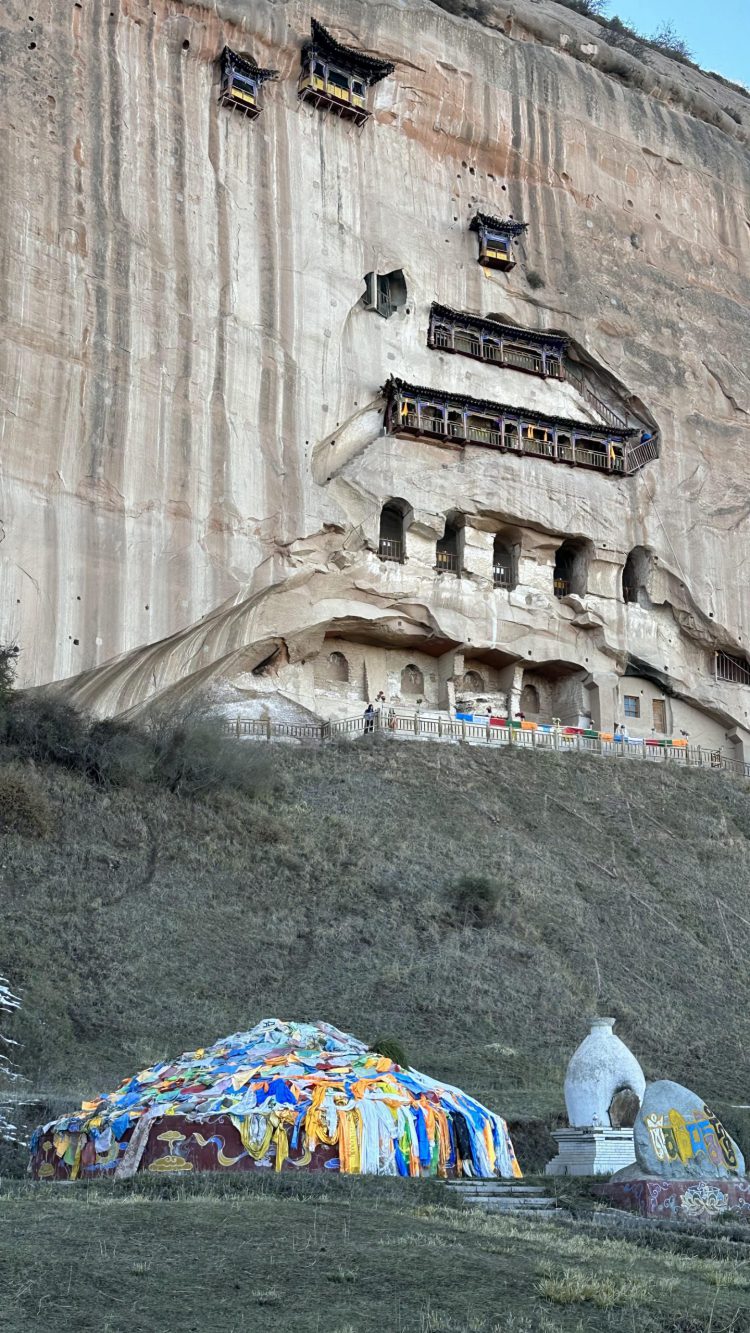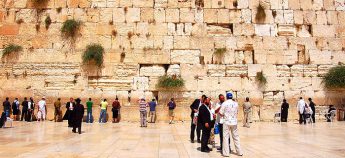Rediscovering history – by leesan
The Hexi Corridor of the ancient Silk road in China is full of amazing wonders.
RECENTLY, I started a journey from Lanzhou in western China’s Gansu province after eating a bowl of the city’s specialty dish, halal Lanzhou ramen. It was so yummy!
After that, I went to Wuwei, and enjoyed visiting the Yellow River stone forest there. Later, I made my way westward along the 800km-long snow-capped Qilian Alps and Mountains…My goal is to trace the foot-steps of pioneers, merchants, administrators, politicians, poets, and travellers of the early years,and feel their sky-high ambitions and aspirations.
But it has been hard for me to imagine how these people were able to find their way, seeing as how back in those times, there were no road signs or marks to guide them. Today, we are lucky to be able to make the trip much more comfortably and safely, and even via high-speed rail.
Perhaps up to this point you might have guessed that I am now treading on the world-famous Silk Road, having passed the Mars Base-Camp 1 in Jinchang, the Badan Jilin Desert in Inner Mongolia, Zhangye Qicai Danxia, Matisi Temple, and Jiayuguan, Jiuquan. I arrived at the mysterious Dunhuang City recently and marvelled at the treasure trove of ancient Buddhist arts found within Mogao Caves.
This very important section of the Silk Road is known as the Hexi Corridor.

Mingsha mountain in dunhuang used to be a key barter station and pit stop for merchants along the Silk road. mogao Caves is just a short distance away.

The columnist and his travel buddies are currently traversing the Silk road via four-wheel drive. Here they are in the heart of the badan Jilin desert, the world’s third biggest desert.— Photos: Leesan
Some 2,162 years ago, Zhang Qian led a 100-men delegation at the order of Emperor Hanwu to the Western Frontiers (known today as Xinjiang) from Changan (or Xi’an). Back then, the compass had just been invented(206BC).
Zhang and his team had been captured twice and detained by the Xiongnu army in Hohhot, Inner Mongolia. With much effort, he managed to escape and continued his journey to theWest.
Finally, Zhang went back to Chang-an to report his findings to the Emperor. He had successfully “opened up” the world-famous Silk Road to China’s Wild West. Zhang’s first expedition took him 13 years to complete.
Zhang made additional expeditions to the Western Frontiers, and managed to foster closer political, economic and cultural cooperation with various states in the West, officially opening up an east-west trade thorough fare. Notably, back then the modes of transportation for Zhang and his people included horses, mules and camels, and they had to traverse rugged terrains and brave through hostile desert sandstorms, so that a 10,000km highway could eventually be established.
Historical records show that the Tang Dynasty saw the pinnacle of prosperity along the Silk Road stretching from Xi’an all the way to Rome in Italy.
The Silk Road remained a thriving trade route for hundreds of years. However, due to the development of the Maritime Silk Road much lateron, the Land Silk Road started to fade into oblivion among the merchants and was actually abandoned for several centuries thereafter.
Time has changed, though. Today, the Hexi Corridor has been given a new lease of life with a modern four to five-lane expressway criss-crossing the region, bringing unprecedented prosperity and wealth to the once impoverished towns and villages littered along the route.
During the journey, our guide from Lanzhou, Li Yuan, chatted with me about the famous Chinese saying, “30 years in Hedong, 30 years in Hexi”, which is all the more significant in today’s context having witnessed the phenomenal rise and fall of the Hexi Corridor, as well as its miraculous rebirth.
Today, travellers from across China are going after more in-depth thematic travelling routes to explore the country and learn more about its history.
Naturally, the Hexi Corridor recently emerged as the fifth most popular domestic travel destination in China.
Staring out of the bus window, all that showed up before my eyes were an endless expanse of empty, seemingly barren land.
Nevertheless, a closer look reveals the fact that dotting the vast expanse of land on both sides of the expressway are countless numbers of massive wind turbines that work in an orderly manner to generate electricity.
It is said that each of these turbines costs at least RM3.5mil.
Together with the huge swathes of solar panels, they are generating electricity and catering to the needs of major population centres in the East, brightening up the night sky of eastern metropolitan areas.
As if that’s not enough, along the expressway, you will also come across white-coloured signboards that mark an even more gigantic engineering project from China – thousands of kilometers of underground natural gas pipelines that also cater to the needs of major population centres in the East.

“Dunhuang Academy” experts set up a three-layer parapet outside the world-famous Mogao Grottoes, a Buddhist Art Museum on Wall, making it easier for tourists to enter according to their reservation number. Howerver, you can only visit 8 caves at a time.

Horseshoe North Temple Grotto, the Tibetan-Buddhism temples built in the Yuan Dynasty, total 39 caves.
Although the Hexi Corridor is sparsely populated, it actually carries with it a humongous responsibility in the modernisation of China.
Even though many things are beyond our control, people throughout the ages must do their utmost for the good of the future generations. People gifted with great wisdom will always overcome the obstacles and impossibilities.
Fortunately, the leaders of China have come to realise that in order to become rich, they will need to first build roads to facilitate the people’s travels.
About 10 years ago, China started to encourage the development of the country’s western frontiers, and decided to diversify the region’s coaldependent industry. Among others, the most notable developments are in agricultural and food production, industrial innovation and cultural tourism. As a result, the region has witnessed an unprecedented influx of investments, while bringing talent and labour back to the West.
We can see from here that the most important thing is for the government to play a proactive role in the development of the local transportation infrastructures such as roads, railways and aviation.
The many big and small towns in previously “backward” places in Gansu, Qinghai and Xinjiang have now been rejuvenated, bringing unimaginable prosperity to China’s “Big West”.
The so-called Silk Road is not actually a physical road, but rather an unmarked network of passages through towering mountains, great rivers and prohibitive deserts. Additionally, “silk” was only one of the many types of merchandise transported along this route.
The establishment of the Silk Road had lured a multitude of merchants, pedlars, travellers and students to ply on this route. The ensuing taxation needs gave rise to local governments for enforcement and management.
The Silk Road later fell into obscurity for several centuries, but the once thriving trade activities and administration have
left behind an invaluable cultural legacy, including the millennia-old Mogao Caves with its precious collection of timelessBuddhist artefacts.
Leaving Dunhuang City, we will continue our journey along the highway toward Liuyuan train station 128km to the west, where we will board the Lanzhou-Xinjiang Express Train to Hami City, 412km away in the Xinjiang Uyghur Autonomous Region, as we continue our journey to trace the One Road, One Belt.
I wrote this piece at the foothills of the Flaming Mountains in Turfan, Xinjiang, the original home of the Hami melons.
Imagine how the ancient merchants brought back the seeds of Hami melons … Today, more than 180 varieties of melons can be found throughout China and beyond, including the fabulous Yubari melons in Japan’s Hokkaido.
Leesan, the globe-trotting traveller who has visited 137 countries and seven continents, enjoys sharing his travel stories and insights. He has also authored five books.

Published in STAR 2, 11 November 2023
全球超过80000家酒店,Apple101助您轻松订房,出行无忧,绝对优惠价。入住期间付款,多数客房可免费取消!











